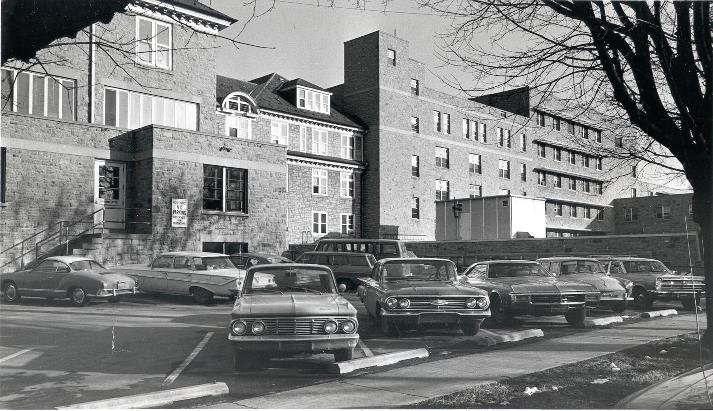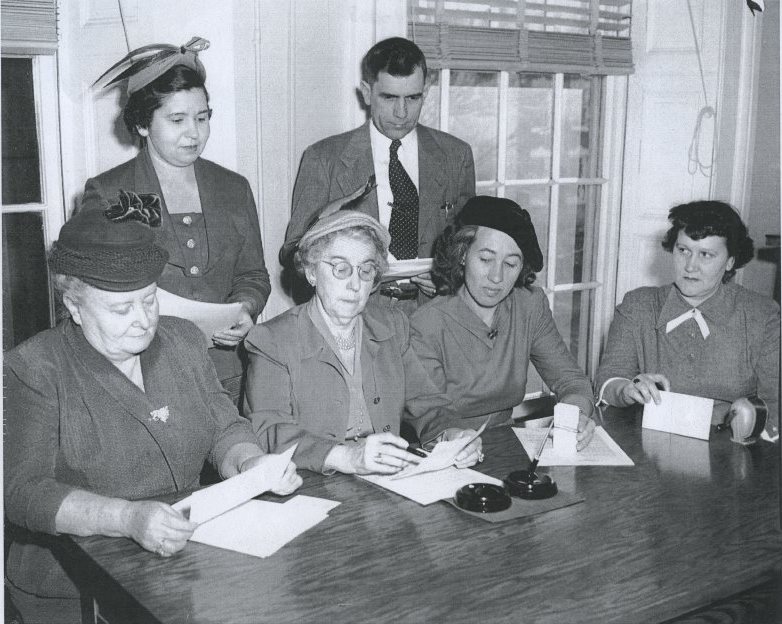Jonas E. Warrell – Businessman, Civic Leader, Benefactor
Jonas E. Warrell was born April 3, 1896 in Conshohocken, Pennsylvania to Albert and Anna Daley Warrell. He graduated from Conshohocken High School in 1913 and attended Drexel University.



Top: Front view of the Carlisle Hospital with two automobiles near entrance (05-A-12)
Middle: Carlisle Hospital; rear view showing parking lot with automobiles (26-13-03)
Bottom: Carlisle Hospital Auxiliary. (ST-0199-TA)
For nearly a century, the Carlisle Hospital complex occupied a block of land in the southwest section of Carlisle. The limestone, landmark building was razed in 2007 following a decision by the hospital board to sell the hospital to Health Management Associates, Inc. of Naples, Florida, who would construct a new hospital in South Middleton Township. This major change was prompted by a need for updated facilities, lack of space for expansion, and lack of available funds for the projected costs of at least $40 million.[1] Given the long presence of the Carlisle Hospital in the community, with its connections to the major life events of a majority of the local residents, the closure of the hospital was not a neutral event.
The original hospital building was erected in 1915 following several decades of the use of other structures in town for hospital services. (The Lydia Baird Home on High Street and the Todd Hospital located at the northwestern corner of the intersection of North West and "F" Streets.) It opened for business on July 24, 1916.[2] At this time, the location was on the edge of the Borough.
There were several major expansions over the course of the life of the hospital. The first occurred in 1931. This renovation involved raising the roof of the building, which created a new floor and allowed for the addition of 75 beds, raising patient capacity from 44 to 90.[3] The modernized hospital joined the ranks of the American Hospital Association at this time. However, in the next several decades, the practice of medicine became more specialized and new physicians with specialty practices entered the local scene with requirements for additional, modern equipment. The hospital boards of the period were reluctant to accept federal funding and the concomitant requirements to meet certain standards or provide particular services, so further modernization awaited additional, local fund-raising. Meanwhile the hospital was straining at the seams with beds in hallways and shortened hospital recovery times.
The crowding was addressed by a new addition to the building (the "B" wing), which was dedicated on May 11, 1950. The new enlargement provided for 100 or more patients, which required that the hospital comply with state regulations that there be a resident physician on the premises at all hours - a first for Carlisle.[4] The medical field was expanding along with hospitals; in the 1940s, the hospital had twenty-four doctors on staff and by 1950, there were forty. At this point in the life of Carlisle Hospital, the main entrance remained on the Parker Street side of the building.
By 1959, the hospital was serving an area of 70,000 residents. The enlargements made in 1950 were no longer adequate for the demands of the larger population, creating a need for larger facilities and another major fundraising campaign. After launching the drive for funds, significant contributions were made by C.H. Masland & Sons and the Carlisle Corporation, two large employers in town, as well as by many individuals and small businesses. There was a groundbreaking ceremony in 1959 and the laying of the cornerstone in 1961; when completed the new facility contained just over 200 beds and represented $8 million in assets.[5] This new addition to the hospital was called the "C "wing.
In the 1960s, the level of volunteerism expanded along with the hospital. Candy Stripers were in the halls assisting hospital staff, and the senior and junior auxiliary groups were actively sponsoring special fundraising events, particularly annual events such as the Christmas Bazaar, a lawn fete, an antique show, several country club dances, and in later years the Follies. Men's service organizations in Carlisle were also regular in their monetary contributions to the hospital. The women's Senior Auxiliary had established a gift shop in the hospital lobby in the early fifties, and this too was expanded over the years. While enhanced from the benefits of volunteers, the hospital also offered professional development through several programs of instruction. In the early 1950s, Carlisle Hospital inaugurated a course of training for practical nurses. In later years, the hospital had training courses for nurse anesthetists, radiologic technologists, and also offered a course in respiratory therapy. A sizable portion of the graduates of these courses remained at the hospital as valued staff members.
During the '50s and '60s, the Carlisle Hospital was the epitome of a small community facility, financially supported by local residents, fairly well-endowed, and generally self-directed, but pressure to expand and modernize continued and became imperative to the life of the hospital. The board of Trustees approved a professional study of the facility in 1966, and ultimately decided on a three-part plan of expansion that commenced in 1969 that was not completed until 1977. The "new" Carlisle Hospital took six years to construct and increased the square footage from 131,900 to 224,806.[6] The new expanded version of the hospital featured a lobby and main entrance that faced Wilson Street. This was the final iteration of the building that was torn down thirty years later.
On February 12, 2006, patients and staff made the final move from Carlisle Hospital to the Carlisle Regional Medical Center. The move began at 7:00 AM and by evening, the former hub of medical treatment, which witnessed the life and death of many regional residents for ninety years, was silent.[7]
Jonas E. Warrell was born April 3, 1896 in Conshohocken, Pennsylvania to Albert and Anna Daley Warrell. He graduated from Conshohocken High School in 1913 and attended Drexel University.
[1] Susan Meehan, The Carlisle Hospital: The Most Important Building in Town, (Carlisle: Carlisle Area Health & Wellness Foundation, 2008), 65.
[2] Ibid., 24.
[3] Ibid., 33.
[4] Ibid., 37.
[5] Ibid., 45.
[6] Ibid., 49.
[7] Ibid., 66.